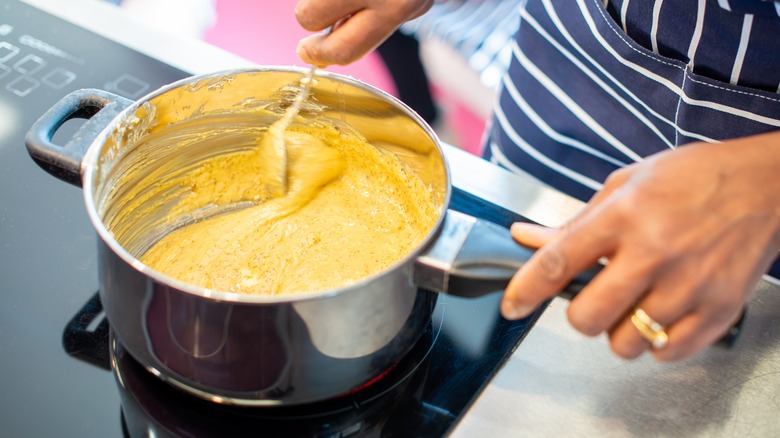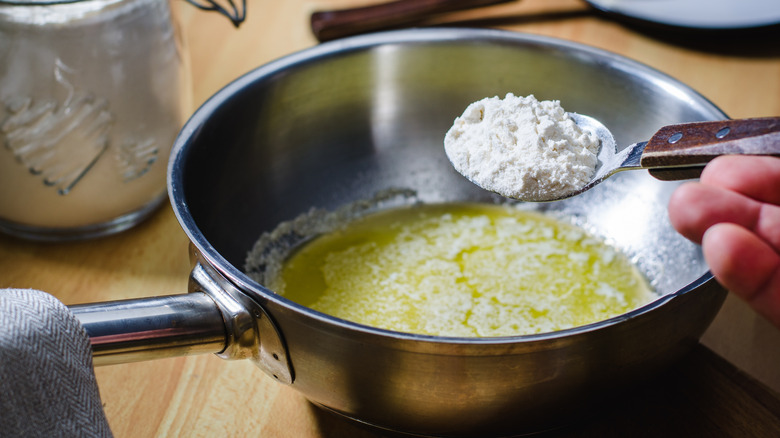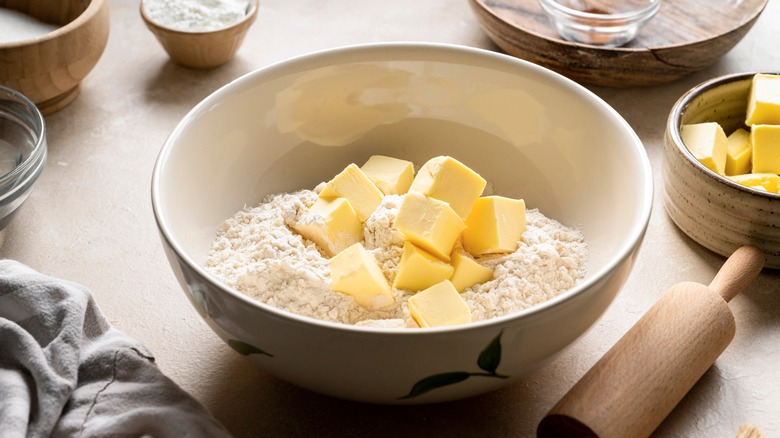The Simple Difference Between A Beurre Manie And A Roux
Leave it to the French to think through cooking from every angle and come up with two specific things — a beurre manie and a roux — that do the same thing but with small, meaningful differences. If anyone is going to get precise with cooking, it's the people who gave us the soufflé and patisserie, so as much as a beurre manie and a roux are going to sound similar, you'll need to put your trust in the expertise of French chefs. However, once you try both techniques, you are sure to find uses for both of them, and a beurre manie may even take the place of the more familiar roux for you.
The most important difference between a beurre manie and a roux is that the latter is cooked and added at the beginning of the process, while the former isn't cooked and is added at the end. Both are made from fats and flour and both are created for the purpose of thickening dishes like stews and sauces, but a beurre manie simply involves mixing butter and flour before adding it directly to cooking liquids without using heat like a roux. This small difference gives the two thickening agents quite unique uses in the kitchen.
What is a roux?
Of the two, roux is the term most familiar to American cooks and is the foundation of a lot of recipes. A roux is simply flour cooked in some kind of fat, usually butter. It's commonly made at the beginning of a recipe and then has additional liquid added to it that gets thickened by the roux as it cooks. The thickening comes mainly from the starch in the flour. When starch molecules get exposed to heat, they eventually burst and release smaller molecules throughout the whole mixture. It's this mixing of the loose starch that slows the movement of all other molecules in the liquid and causes it to thicken. Other starches, like cornstarch, work the same way.
The main reasons the flour gets cooked in hot fat with a roux is to alter the flavor and smooth out the texture. The heat cooks off the raw flour flavor, improving the taste of the final dish, and the fat also coats the individual grains of flour, which prevents them from clumping the way they would if you just added flour straight to the liquid. The cooking also opens up possibilities for flavoring a dish. Roux can be cooked to a golden color or even a dark color, like the roux in Cajun and Louisiana Creole cooking, which imparts increased complexity and a smoky, toasted flavor.
What is a beurre manie?
A beurre manie is also a fat and flour mixture, but in this case, it is always butter. Rather than being heated in a pan like a roux, it gets turned into a paste before being cooked. This is done by kneading an equal amount of butter and flour together on the counter. It can then be added directly to hot liquids to thicken them. In practice, it works very similarly to a roux: The butter prevents the flour from clumping, and the flour cooks to thicken the dish. But, not having to be heated ahead of time makes it more flexible in its use, although you lose the flavor boost of cooking the flour.
The main purpose of a beurre manie is to thicken the consistency of a sauce or soup at the end of cooking, as opposed to the beginning like with a roux. This means that small and precise adjustments can be made, whereas roux is harder to modify once the liquid has been incorporated. Rouxs can also lose their ability to thicken when the dish is cooked for a long time, so beurre manies can be used to modify slow-cooked meals at the end, whereas a roux would be less effective. As a little bonus, the uncooked butter will also add some richness to the finish of your dish. Both beurre manie and roux have their unique advantages and purposes, and you can even combine both if you need to.


